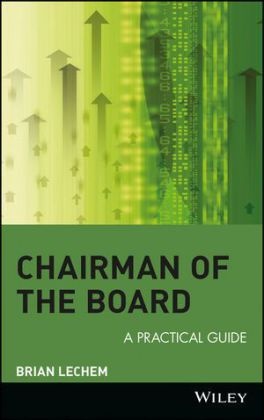Read more
Informationen zum Autor BRIAN LECHEM is President of Boardroom Advisory Services, a consulting practice, and editor of Boardroom newsletter, based in Toronto, Canada. He is founder President, a fellow, and former executive director of the Institute of Corporate Directors, a Canadian organization allied with the National Association of Corporate Directors in the U.S. and the Institute of Directors in the U.K. Klappentext Practical, real-world advice for the most challenging of positionsThe role of the chairman of the board is an art form that varies with the size, type, and corporate climate of the organization. Chairman of the Board provides practical guidance on this critical role, offering advice on matters such as how to work with the CEO, ethical considerations, corporate social responsibility, and performance evaluation of boards and board members. Seasoned executive Brian Lechem discusses regulatory requirements and legal exposures relating to board responsibilities and how to minimize risks to company resources. Real-life examples illustrate how challenges have been met by companies with both positive and negative results. Information on board regulations for not-for-profit and government agencies and Canadian and U.K. companies lends the book broad appeal. Zusammenfassung This book provides guidance on the job of the chairman of the board, what it entails and how it should be fulfilled. It contains practical advice on matters such as how to work with the CEO, ethical considerations, corporate social responsibility, and performance evaluation of boards and board members. Inhaltsverzeichnis Introduction. A Question of Style. Origin of the Role of Chairman. The Art of Chairmanship. Leadership and Style. Chapter 1. Primus Inter Pares. First Among Equals. The Chairman's Role. What the Position Entails. Leadership. Chapter 2. Building the Board. The Selection Process. Achieving a Balance. Credentials and Qualifications. Remuneration of Independent Directors. Orientation and Training. If Things Go Wrong. Chapter 3. Separation of Roles or Concentration of Power? One Job--or Two? Interrelationship of the Roles. Balancing the Roles. The Chairman's Job Is Different. It Is Lonely Being a Chief Executive. Succession Planning. Chapter 4. Establishing the Agenda. The Board in Action. The Principle of Collective Responsibility. Direction and Management. How the Board Works. Statutory Responsibilities. Board Procedures. Choosing the Issues. Information Flow. The Real Agenda in Decision Making. Boards That Do Not Direct. Chapter 5. Setting the Direction. Board Involvement in the Process. Developing Strategic Thinking. Goals and Objectives. The Role of Management. Maintaining Oversight. Chapter 6. The Minefield of Legal Liability Exposure. Interpreting the Situation. The Statutory Position. When to Seek Advice. Danger Signals. A Sense of True Perspective. Diligence and the Strategy Process. Some Specific Areas of Vulnerability. How Much Diligence? Assumption of Risk. Chapter 7. Delegation--The Use of Board Committees. The Board Remains Accountable. Spreading the Load. Key Board Committees. Maintaining Effective Reporting Links. Chapter 8. Board Evaluation--Assessing the Passing Grade. The Concept of Board Performance. Performing Effectively. Assessing How the Board ...

